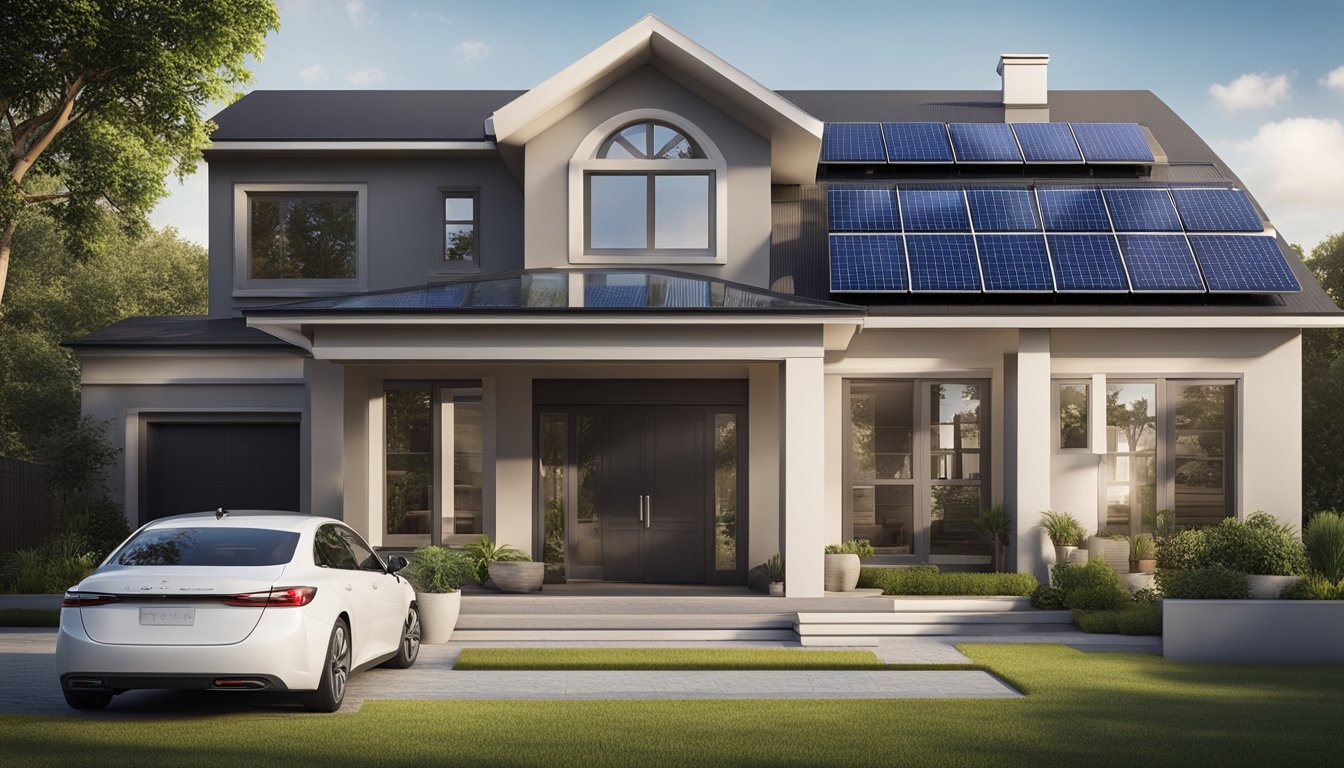Late updated: 18 Aug 2024 16:08
Written by: Eleanor Hartman
Emerging Trends In Home Energy Management Systems: Innovations and Future Directions
Home energy management systems (HEMS) are rapidly evolving to address the growing demand for sustainable and efficient energy solutions in our homes. With the integration of smart devices and advanced software, HEMS help homeowners monitor and optimise their energy consumption, reduce costs, and contribute to a greener environment. One of the most significant trends is the use of renewable energy sources, such as solar panels, seamlessly integrated with HEMS to maximise energy efficiency and reduce dependency on the grid.

Consumer interest is driving innovation in HEMS, leading to increasingly sophisticated systems capable of learning user behaviour and adjusting energy use accordingly. These systems provide real-time data and actionable insights, empowering users to make more informed decisions about their energy consumption. Smart devices, from thermostats to lighting controls, play a crucial role in enhancing the functionality and user experience of HEMS.
Despite the clear benefits, challenges remain in the widespread adoption of HEMS, such as the need for reliable internet connectivity and the initial investment cost. Nonetheless, the opportunities for energy efficiency and cost savings make HEMS an attractive option for many households. As technology continues to advance, we can expect even more intuitive and integrative solutions in the future.
Key Takeaways
- HEMS integrate smart devices and renewable energy to improve efficiency.
- Consumer demand is driving the innovation of more sophisticated HEMS.
- Challenges like cost and connectivity need to be addressed for broader adoption.
Fundamentals of Home Energy Management Systems

Home Energy Management Systems (HEMS) are designed to optimise electricity consumption in residential buildings through real-time monitoring and data collection. These systems leverage advanced technologies such as artificial intelligence (AI) and the Internet of Things (IoT) to integrate diverse energy sources, including renewable options like solar panels, to achieve maximum efficiency and energy savings.
Understanding HEMS
HEMS, or Home Energy Management Systems, are critical for managing electrical energy within residential spaces. These systems monitor and control various household devices to optimise energy consumption. They use sensors and real-time data collection to track energy usage patterns.
A key feature is demand-side optimisation. By adjusting the load on the electrical grid, HEMS ensure efficient energy use without compromising comfort. These systems also promote energy savings by automatically setting devices to operate during off-peak hours.
Technological Backbone of HEMS
The core technologies powering HEMS are rooted in IoT and AI. IoT enables seamless communication between devices via protocols like Zigbee. AI and machine learning algorithms process vast amounts of data for real-time decision-making.
Big data analytics enhances the system's ability to forecast energy needs and optimise performance. These technologies allow HEMS to operate efficiently within smart grids, facilitating improved energy distribution and reduced wastage.
Communication technologies are crucial for connecting various components, ensuring all systems work together harmoniously. Additionally, the pervasive nature of these technologies makes them easily adaptable to existing home infrastructure.
Integration with Renewable Energy
One significant trend in HEMS is their integration with renewable energy sources. Solar panels and wind turbines are commonly connected to these systems, enabling sustainable energy generation. HEMS can balance energy consumption and production, ensuring maximum efficiency.
Microgrids play a pivotal role in this integration by supporting local generation and storage of renewable energy. These small-scale power grids work alongside HEMS to stabilise energy supply. Moreover, this setup allows residential buildings to become more self-sufficient and less reliant on traditional power sources.
By leveraging sustainable energy sources, HEMS contribute to a greener and more efficient energy ecosystem. This integration not only benefits the environment but also offers cost savings for consumers.
Challenges and Opportunities in HEMS
Home Energy Management Systems (HEMS) are becoming pivotal in enhancing energy efficiency and reducing costs for households. Despite their benefits, they face challenges in security, privacy, and environmental implications, which also present unique opportunities.
Improving Energy Efficiency and Savings
Improving energy efficiency remains one of the primary goals of HEMS. The systems help in load forecasting and energy distribution optimisation through mathematical programming and advanced algorithms. By predicting energy consumption patterns, HEMS can balance load to prevent waste.
However, the limitations include the need for reliable data and resilience in energy infrastructure. Users may also experience variability in cost savings due to fluctuating energy prices. Despite these challenges, the potential for energy savings and cost reduction is substantial, making HEMS an attractive investment.
Security and Privacy Concerns
Security and privacy are significant concerns with HEMS. With the integration of smart devices, the risk of cyber-attacks increases. Data protection laws necessitate stringent measures to safeguard user information. Blockchain technology offers a potential solution by ensuring secure and transparent energy trading.
However, implementing these measures can be costly and complex. Reliability in terms of security protocols must be maintained to build user trust. Addressing these issues presents an opportunity to enhance the robustness of HEMS, making them more secure and reliable.
Environmental Implications
HEMS play a crucial role in addressing environmental sustainability and climate change. By optimising energy usage, HEMS contribute to the reduction of CO2 emissions and promote global warming mitigation. The efficient use of energy resources leads to a decrease in overall energy consumption, positively impacting the environment.
Nevertheless, widespread adoption of HEMS depends on the development of cost-effective technologies that are accessible to all. The potential to significantly influence environmental sustainability makes HEMS an essential component in the fight against climate change. By continuously improving their efficiency and integrating renewable energy sources, HEMS can substantially reduce the carbon footprint of households.
Frequently Asked Questions

Home energy management systems (HEMS) have evolved significantly with advancements in technology, providing a range of functionalities and features aimed at improving energy efficiency. Here, we address some common questions about HEMS, covering their functionalities, the role of AI, smart home automation, market projections, renewable energy integration, and adoption challenges.
What are the primary functionalities of contemporary home energy management systems?
Modern home energy management systems offer comprehensive energy monitoring and control, enabling users to track their energy consumption in real-time. They typically include features like solar PV system integration, battery storage, and remote management through web-based portals or smartphone apps. These systems can automate energy usage, optimising efficiency and reducing costs.
How significant is the role of artificial intelligence in enhancing home energy efficiency?
Artificial intelligence plays a critical role in enhancing the efficiency of home energy management systems. AI algorithms analyse energy consumption patterns, predict energy needs, and automate usage to coincide with energy availability and cost. This predictive capability can significantly reduce waste and optimise energy utilisation, making homes more energy-efficient.
In what ways can smart home automation contribute to energy savings?
Smart home automation contributes to energy savings by integrating various smart devices and systems, such as thermostats, lighting, and appliances. Automated routines can adjust lighting and temperature based on occupancy and time of day, thereby reducing unnecessary energy consumption. This seamless integration helps in creating a more energy-efficient home environment.
What are the market projections for home energy management systems in the upcoming years?
The home energy management systems market is projected to grow rapidly in the coming years. For instance, the North American market size surpassed USD 1.4 billion in 2023 and is expected to grow at a CAGR of over 7.1% from 2024 to 2032. Globally, the market is anticipated to reach USD 104,360.3 million by 2033, driven by increasing power consumption and technological advancements.
How does the integration of renewable energy sources influence home energy management?
The integration of renewable energy sources such as solar panels significantly enhances the functionality of home energy management systems. By incorporating solar PV systems and battery storage, HEMS can manage energy generation, storage, and consumption more effectively. Renewables help reduce reliance on grid electricity, lower utility bills, and contribute to a smaller carbon footprint.
What are the challenges in adopting home energy management systems on a widespread scale?
Several challenges hinder the widespread adoption of home energy management systems. High initial costs for installation and setup, limited awareness about the benefits, and the complexity of integrating with existing home infrastructure are common barriers. Additionally, privacy concerns related to data collection and usage can also impede adoption. Addressing these issues is essential for broader market acceptance.